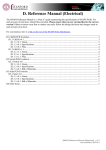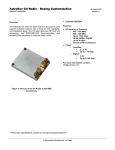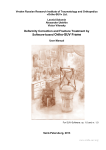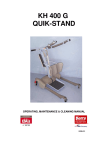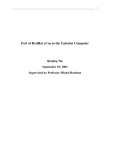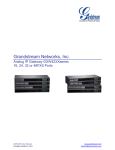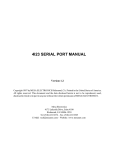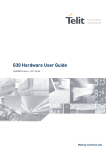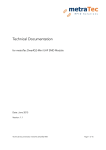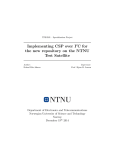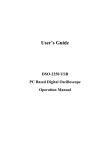Download Astrodev Li-1 radio - Astronautical Development LLC
Transcript
Li-1 Radio Astronautical Development, LLC www.astrodev.com __________________________________________________________________________________________________________ Overview Applications: The Lithium radio product line provides a CubeSat compatible communication system for extreme environment applications. Lithium radios feature on-the-fly selectable frequency selection and output power. They are compatible with standard amateur radio ground stations capable of communication at 9600 bps, or higher bit rates using GMSK modulation. • CubeSat Kit systems • High altitude balloon missions • Rovers or other remotely operated vehicles • Remote embedded systems The Lithium series radios (Li-1) are half-duplex radios with adjustable communications parameters. Custom frequencies and deviations are available per customer requirements. • FSK/GMSK transceiver • Frequencies: o 130 – 450MHz • Input voltages: o Digital 3.3V o Radio power supply (5-9V) • Output transmit power: 250 mW – 4 W • Power usage: o Receive < 200 mW o Transmit: < 10 W 1 • Data rate: 9.6 kbps 2 • Protocol support: AX.25 • Serial interface: 3.3V UART • Form factor: o SMT module (32 mm x 62 mm) • Operating Temperature: -30 to +70 °C The Lithium series radios are available as an SMT module that can be placed on a half size PC104 board or can be integrated into larger more complex systems without incurring RF complexity in host products. A digital command and data interface is provided to the radios. Through this interface the radio is configured, data is received, and data is sent for transmission. The interface protocol is serial UART and configurable up to 115.2 kbps. A packet protocol with checksums is implemented between the host and radio for robust access. The radios communicate using a subset of the AX.25 packet protocol (custom protocols can be ordered). The AX.25 packet source and destination call signs are configurable. Features: Options: • AES 128 or 256 Encryption 3 • Connector options RA SMA, MCX For more information, contact: [email protected] Li-1 emits RF radiation that may interfere with the use of other devices. Users must maintain proper licenses during operation. Li-1 is static sensitive, take the necessary precautions Figure 1--Picture of the Li-1 Radio. Li-1 requires proper termination of transmitter in 50 Ohm load during operation. 1 Transmission power is configurable by the user. Maximum is noted. Higher data rates require special licensing, 38.4kpbs, 76.8kbps. 3 Encryption not AX.25 compliant. 2 © Astronautical Development, LLC www.astrodev.com TABLE OF CONTENTS ABSOLUTE MAXIMUM RATINGS ...................................................................................................................... 3 PHYSICAL CHARACTERISTICS ........................................................................................................................ 3 INTERFACE PIN DESCRIPTION......................................................................................................................... 3 LITHIUM MODULE SCHEMATIC DESCRIPTION............................................................................................... 4 PROGRAMMING PORT PIN DESCRIPTION ...................................................................................................... 4 LITHIUM MODULE PROGRAMMING PORT SCHEMATIC DESCRIPTION ...................................................... 4 COMMUNICATING WITH THE LITHIUM RADIO................................................................................................ 5 RADIO CONFIGURATION PROGRAM ............................................................................................................... 5 DIMENSIONS AND FORM FACTOR................................................................................................................... 6 RECOMMENDED FOOTPRINT ........................................................................................................................... 6 PROTECTING AGAINST ELECTROSTATIC DISCHARGE ............................................................................... 7 TRADEMARKS..................................................................................................................................................... 7 DISCLAIMER........................................................................................................................................................ 7 NOTES .................................................................................................................................................................. 7 © Astronautical Development, LLC Li-1 User Manual 2 of 7 Revision 0.4 – 9/1/2009 ABSOLUTE MAXIMUM RATINGS Interface Parameter Operating temperature DC Amplifier Voltage DC Amplifier Current DC 3.3V Radio Voltage DC 3.3V Radio Current Symbol TOP Vamp Iamp Vsys Isys Min. Nom. Max. -30.0 to +70.0 5.0 9.0 0.1 1.5 3.0 3.3 3.6 0.02 0.03 0.07 Units ˚C V A V A Input and Output Pins Input Voltage Logic High Input Voltage Logic Low Current Source High Current Sink Low Symbol Vhigh Vlow Ihigh Ilow Min. 2.6 0.0 Max. 3.6 0.66 Units V V mA mA RF Interface RF Output Symbol Min. 28 Nom. Max. 34 Units dBm Symbol M H W L Min. 48 0.0 Typ. Max. 52 10 33 65 Units g mm mm mm Nom. 3.3 10 10 PHYSICAL CHARACTERISTICS Physical Parameter Mass Height Width Length 32 64 Please refer to IGS file information at www.astrodev.com for physical characteristics. INTERFACE PIN DESCRIPTION Interface Pin Name TX_UART RX_UART RESET GND 3.3V_RADIO V_AMP V_AMP RF_GND RF_GND N/C GND External_Event Config_Pin_2 Config_Pin_1 Thermal_PAD Pin # 1 2 3 4 5 6 7 8 9 10 11 12 13 14 15 © Astronautical Development, LLC Notes UART TX, Information Out UART RX, Information In Reset radio, logic low Radio supply ground 3.3V Radio supply Amplifier Voltage Amplifier Voltage Amplifier Ground Amplifier Ground N/C Radio supply ground External event pin, configurable output External configuration pin, logic input External configuration pin, logic input Bottom pad for thermal dissipation, connect to RF_GND Li-1 User Manual 3 of 7 Revision 0.4 – 9/1/2009 LITHIUM MODULE SCHEMATIC DESCRIPTION PCB RESET VCC_SYS TX_UART RX_UART RESET GND 3.3V_RADIO 6 7 8 9 V_AMP V_AMP RF_GND RF_GND Config 1 Config 2 External Event GND N/C 14 13 12 11 10 Config_Pin_1 Config_Pin_2 External Event N/C 15 RADIO_RAW_VOLTAGE_IN RADIO_RAW_VOLTAGE_IN RF_GND1 RF_GND1 1 2 3 4 5 RF GND TX_Uart RX_Uart RF_GND1 Li-1 Mount Module Figure 2 Lithium PCB Mount Module Schematic Diagram PROGRAMMING PORT PIN DESCRIPTION Program Pin Name DATA CLOCK RESET DATA TCK 3.3VD TDI TMS TDO GND N/C Pin # 1 2 3 4 5 6 7 8 9 10 Notes Reserved JTAG Processor Reset Reserved JTAG Clock JTAG 3.3V Power JTAG Data In JTAG Test Mode Select JTAG Data Out Ground No Connection LITHIUM MODULE PROGRAMMING PORT SCHEMATIC DESCRIPTION Prog DATA_CLOCK_11 DATA_11 +3.3VD M1_TMS 1 3 5 7 9 2 4 6 8 10 M1_RST/NMI M1_TCK M1_TDI M1_TDO Header 5X2 Figure 3 Programming Port Schematic Diagram The programming adapter provided with the radio converts the 1.27mm connector to a standard 0.1” JTAG header. The JTAG adapter plugs inline with the radio with the majority of the adapter pointed away from the Li1 radio. In the following figure demonstrates the proper mating of the JTAG adapter. © Astronautical Development, LLC Li-1 User Manual 4 of 7 Revision 0.4 – 9/1/2009 Figure 4 JTAG Adapter Plug Demonstrations COMMUNICATING WITH THE LITHIUM RADIO Refer to AstroDev radio interface application note for detailed instructions. RADIO CONFIGURATION PROGRAM Refer to radio configuration program application note for detailed instructions. © Astronautical Development, LLC Li-1 User Manual 5 of 7 Revision 0.4 – 9/1/2009 DIMENSIONS AND FORM FACTOR For detailed dimension information please refer to IGS model on www.astrodev.com Figure 5 – Li-1 Radio (All dimensions in mm) RECOMMENDED FOOTPRINT Figure 6 Recommended PCB Footprint (All dimensions in mm) Please refer to www.astrodev.com for footprints in PCB layout programs. © Astronautical Development, LLC Li-1 User Manual 6 of 7 Revision 0.4 – 9/1/2009 Mounting of the Li-1 module using hand soldering is recommended. An iron temperature of 350°C should be used with IPC recommendations / reference documents IPC7711. Place the module precisely on the pads. Start with a cross-diagonal fixture soldering (e.g. pins 14 and 9), and then continue from left to right. Thermal compound should be applied to the thermal conduction area under the module. The thermal conduction area should include through hole vias that connect to a ground plane to promote thermal dissipation. Proper analysis is required to ensure that the module is able to properly dissipate heat within its application environment. Reflow or wave soldering of the Li-1 module is not recommended. Thermal dissipation through the module heatsink occurs in high temperature environments resulting in inconsistent soldering joints. Conformal coating or casting of the module is permitable as long as thermal analysis is performed to realize the new thermal environment. The module should be operated at as low temperature as possible toward a nominal 20 °C to increase overall efficiency and precise operation. PROTECTING AGAINST ELECTROSTATIC DISCHARGE CAUTION: Disconnect the Li-1 radio from power source before removing from operating environment. Electrostatic discharge (ESD) events can harm electronic components inside the Li-1. Under certain conditions, ESD may build up on your body or an object, such as an antenna, and then discharge into another object, such as the Li-1. To prevent ESD damage, you should discharge static electricity from your body before you interact with any electronic components. You can protect against ESD and discharge static electricity from your body by touching a metal grounded object (such as an unpainted metal surface such as your antistatic surface) before you interact with anything electronic devices. When connecting an antenna or power plug to the Li-1, you should always ground both yourself and the CubeSat structure before connecting it. You can also take the following steps to prevent damage from electrostatic discharge: • When unpacking the Li-1 from its shipping carton, do not remove the radio from the antistatic packing material until you are ready to install the component. Just before unwrapping the antistatic package, be sure to discharge static electricity from your body by wearing an antistatic wrist strap. • When transporting the Li-1, first place it in an antistatic container or packaging. • Handle the Li-1 in a static-safe area. If possible, use antistatic floor pads and work bench pads. TRADEMARKS In progress. DISCLAIMER All information in this document is subject to change at anytime. Look for continued updates at: http://www.astrodev.com/ Lithium radios are sold as test devices and require users to gain experimental license from the FCC for use in terrestrial and CubeSat satellite missions. NOTES © Astronautical Development, LLC Li-1 User Manual 7 of 7 Revision 0.4 – 9/1/2009







